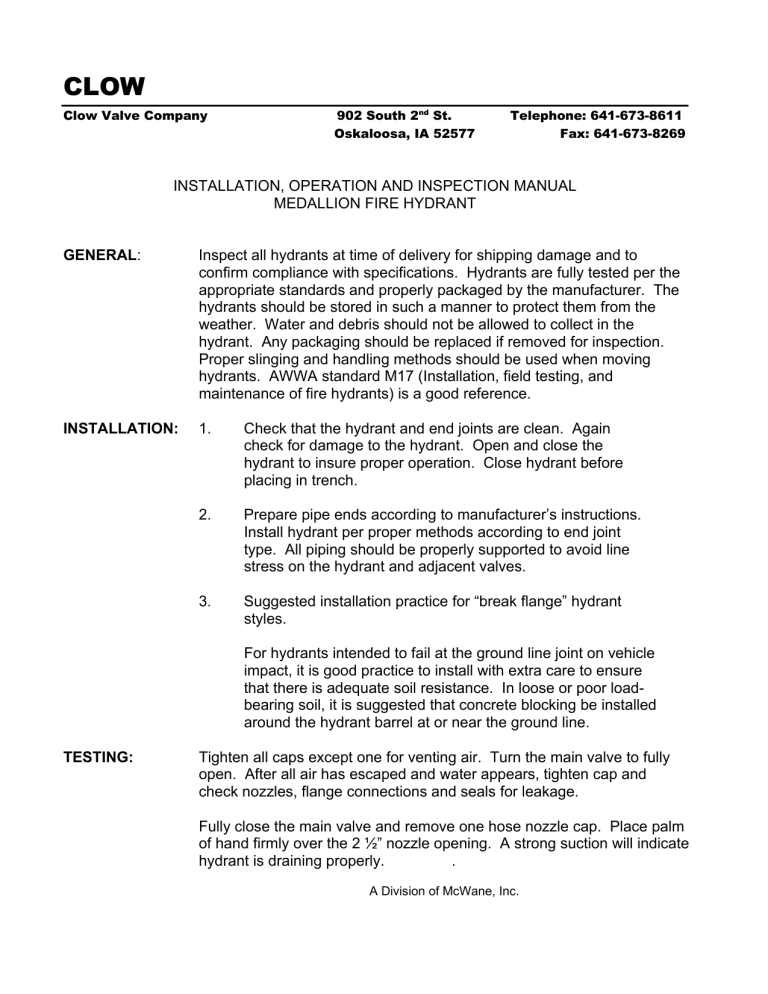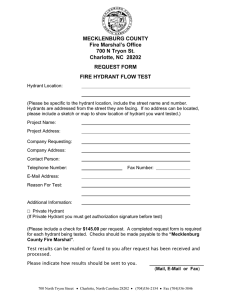INSTALLATION, OPERATION AND INSPECTION MANUAL

CLOW
Clow Valve Company 902 South 2 nd St. Telephone: 641-673-8611
INSTALLATION, OPERATION AND INSPECTION MANUAL
MEDALLION FIRE HYDRANT
GENERAL : Inspect all hydrants at time of delivery for shipping damage and to confirm compliance with specifications. Hydrants are fully tested per the appropriate standards and properly packaged by the manufacturer. The hydrants should be stored in such a manner to protect them from the hydrant. Any packaging should be replaced if removed for inspection.
Proper slinging and handling methods should be used when moving hydrants. AWWA standard M17 (Installation, field testing, and maintenance of fire hydrants) is a good reference.
INSTALLATION: 1. Check that the hydrant and end joints are clean. Again check for damage to the hydrant. Open and close the
TESTING:
2. Prepare pipe ends according to manufacturer’s instructions.
Install hydrant per proper methods according to end joint type. All piping should be properly supported to avoid line stress on the hydrant and adjacent valves.
3. Suggested installation practice for “break flange” hydrant styles.
For hydrants intended to fail at the ground line joint on vehicle impact, it is good practice to install with extra care to ensure that there is adequate soil resistance. In loose or poor load- bearing soil, it is suggested that concrete blocking be installed around the hydrant barrel at or near the ground line.
Tighten all caps except one for venting air. Turn the main valve to fully open. After all air has escaped and water appears, tighten cap and check nozzles, flange connections and seals for leakage.
Fully close the main valve and remove one hose nozzle cap. Place palm of hand firmly over the 2 ½” nozzle opening. A strong suction will indicate hydrant is draining properly. .
A Division of McWane, Inc.
CLOW
Clow Valve Company 902 South 2 nd St. Telephone: 641-673-8611
Oskaloosa, 52577
INSTALLATION, OPERATION AND INSPECTION MANUAL
MEDALLION FIRE HYDRANT
INSPECTION
AND
Fire hydrants should be flushed, inspected and tested twice a year
(spring and fall), to ensure satisfactory operating condition.
MAINTENANCE
Visually inspect for damaged, loose or missing parts.
With the main valve fully closed, remove nozzle caps and check for water in the barrel. The presence of water indicates one of
A. Leakage of the main valve.
B. Drains are below ground water table level.
C. Drains obstructed by soil or other foreign material.
D. Nozzle caps replaced prior to allowing barrel to drain.
While nozzle caps are removed, check for thread damage. Wire brush nozzle and cap threads and apply antiseizing lubricant.
Replace nozzle caps and check for free action of cap chains. If chains bind, open cap loop until rotating action is free.
RECOMMENDED Bonnet O’ring (M32), Op Nut O’ring (M1), Thrust Nut O’ring (M28),
SPARE PARTS Main Valve Repair Kit, Break Flange Repair Kit
RECORDS
1. Inspection records are an integral part of a good maintenance program.
2. A printed 5 x 8 record card for each valve and hydrant in the system is most convenient. a. Identification of each valve and hydrant is essential. Setting up a numbering system is one of the first steps to take. A reasonably simple method is to assign a number to each street intersection, then identify each valve or hydrant numerically or alphabetically between intersection numbers.
For instance:I9-I10 would be the number of second valve from street intersection number 9 in going toward street intersection number 10.
Another convenient device is to assign only odd numbers to existing hydrants. When hydrants are added later, they can be given numbers which will fit in the numerical sequence. b. Location should be recorded first. Measurements must be made from property lines or street center lines; not power poles, fence lines, or the like.
----------------------------------------------------------------------------------------------------------------------------
VALVE RECORD
Location ______________ FT. _______ of _______ Prop. Line of __________________ and ____________ FT. _______ of _______ Prop. Line of __________________
Size ______ Make __________ Type_________ Gearing _________ Bypass ________
Opens ______ turns to Operate __________________ Depth to Nut _______________
Remarks: ______________________________________________________________
______________________________________________________________________
MAINTENANCE AND INSPECTION RECORD
Date Work Done O.K. By Date Work Done O.K. BY
______________________________________________________________________________
______________________________________________________________________________
Clow Valve Company
PRODUCT DATA SHEET
PROCEDURE FOR REMOVING VALVE ASSEMBLY FROM
CLOW MEDALLION HYDRANT
(Refer to Data Sheets 2545-7, 8 9)
Before commencing disassembly procedure, shut off water in main controlling flow to hydrant inlet.
1. Open hydrant partially to relieve pressure in line, then close hydrant completely.
2. Remove weather cap hold down screw (M-25) and weather cap M-26).
3. Remove thrust nut (M-27), with thrust nut wrench, by turning clockwise. Note: on open right hydrants, set screw (M-58) must be removed before thrust nut can be removed.
4. Remove operating nut (M-3) and thrust bearings (M-2), by turning counter- clockwise on open left hydrants and clockwise on open right hydrants.
5. Insert hydrant wrench over upper stem (M-7) and lower into bonnet (M-30) until socket engages hex jam nut (M-4). Remove nut by turning in same direction as operating nut (M-3). Note: Omit this step if stop is in shoe.
6. Slide the bonnet assembly sleeve over the threads of the upper stem (M-7) and lubricate the outside to protect the o-rings from thread damage when removing/ replacing the bonnet (M-30).
7. Remove bonnet bolts and nuts (M-29) and then remove bonnet (M-30) from top of nozzle section (M-33).
8. Lower hydrant wrench, with guide attached, over upper stem (M-7) until slots in wrench are engaged with upper stem pin (M-8) on upper stem (M-7).
9. Insert operating nut (M-3) (remove thrust bearings (M-2) inside of wrench and thread it onto upper stem (M-7). (This will secure the wrench to the stem).
10. Center wrench in nozzle section (M-33), adjust guide to fit inside opening of nozzle section (M-33) and lift wrench to assure fully closed seat, then tighten thumb screw.
11. Unscrew seat ring (M-19) by turning counter-clockwise approximately five full turns. Valve assembly can now be lifted out of hydrant.
Clow Valve Company
PRODUCT DATA SHEET
PROCEDURE FOR REMOVING VALVE ASSEMBLY FROM
CLOW MEDALLION HYDRANT
(Refer to Data Sheets 2545-7, 8 9)
12. Bolt into place the two new extension flanges (M-60) using new bolts and nuts (M-46). Note: Extension flanges have no grooves. Flanges should fit snugly around barrel. Tighten bolts and nuts evenly to a minimum of
75 foot/pounds torque.
13. Assemble upper stem (M-7) and safety stem coupling (M-10) to extension stem (M-62) and retain it with coupling pin (M-11) and coupling cotter pin
(M-9). Note: Stem coupling is assembled with pin hole closest to the edge towards the bottom.
14. Place new flange o-ring (M-47) into recess on barrel extension flange (M-63).
Clean sealing surface of nozzle section (M-33). Lower nozzle section (M-33) carefully onto barrel extension flange (M-63). Be sure that it is concentric with barrel extension flange and that o-ring is centered.
15. Bolt into place the two safety flanges (M-49) using bolts and nuts (M-46).
Note: Groove in safety flange should face upward. Flanges should fit snugly around barrel (M-50). Tighten bolts and nuts evenly to a minimum of 75 foot-pounds torque.
16. Check bonnet o-ring (M-32). Lubricate exterior of brass upper stem sleeve
(M-5) on upper stem (M-7). Slide bonnet assembly sleeve over threads of upper stem and lubricate. Slide bonnet (M-30) over upper stem and assemble bonnet bolts and nuts (M-29) hand tight.
17. Screw hex jam nut (M-4) onto upper stem (M-7). Tighten with hydrant wrench to 100 foot/pounds torque. Note: Omit this step if stop is in shoe.
18. Fill bonnet reservoir with lubricant. Remove bonnet assembly sleeve.
19. Insert one thrust bearing (M-2) into bonnet (M-30) recess. Screw operating nut
(M-3) onto upper stem (M-7). Insert one thrust bearing (M-2) on top of operating nut (M-3).
20. Slide thrust nut (M-27) over operating nut (M-3) and tighten to 75 foot/pounds torque. Note: Be sure o-ring seals on operating nut and thrust nut are in good condition and lubricated before assembling. If open right hydrant, replace setscrew (M-58).
21. Replace weather cap (M-26) and tighten weather cap hold down screw (M-25) to 25 foot/pounds torque.
Clow Valve Company
PRODUCT DATA SHEET
PROCEDURE FOR REMOVING VALVE ASSEMBLY FROM
CLOW MEDALLION HYDRANT
(Refer to Data Sheets 2545-7, 8 9)
22. Tighten bonnet bolts and nuts (M-29) evenly to a minimum of 75 foot- pounds torque.
23. Loosen one hose nozzle cap slightly to bleed air. Open hydrant fully. Tighten the hose nozzle cap when water starts flowing and check all joints for leakage.
Close hydrant fully. Remove hose nozzle cap to allow hydrant to drain.
Replace hose nozzle cap when drained.
Clow Valve Company
PRODUCT DATA SHEET
PROCEDURE FOR INSTALLING MAIN VALVE SEAT
REPAIR KIT ON CLOW MEDALLION FIRE HYDRANT
1. Remove valve assembly from the hydrant. (Refer to procedure for removing valve assembly, data sheets 2545-7, 8, 9, & 10).
Note: For following procedures, a suitable holding fixture, such as a pipe vise, will be required.
2. Remove lower valve plate (M-24), lower valve plate lock washer (M-22), and main valve seat (M-21) from lower stem (M-12).
3. If drain valve facings need replacing, continue with this step, if not, proceed on to step 4.
A. Remove upper valve plate (M-17) from lower stem (M-12).
B. Remove seat ring (M-19) from wings of upper valve plate (M-17).
C. Replace two drain valve facings (M-16) with new drain valve facing pins (M-15).
D. Slide seat ring (M-19) onto upper valve plate (M-17). Be sure the two wings on the upper valve plate (M-17) engage the two slots on the seat ring (M-19). (See illustration on 2545-22 for proper orientation of seat ring).
E. Slide upper valve plate (M-17) and seat ring (M-19) onto lower stem
(M-12), engaging slots on upper valve plate with lower stem pin (M-13) on lower stem (M-12).
4. Replace upper (M-18) and lower (M-20) seat ring o-rings on seat ring (M-19).
Note: O-rings are different sizes. Upper seat ring o-ring is slightly larger than lower seat ring o-ring.
5. Install new main valve seat (M-12), lower valve plate lock washer (M-22) and lower valve plate (M-24). Tighten to 300 foot-pounds torque.
6. Lubricate o-rings and threads on seat ring and reinstall the main valve assembly.
CLOW VALVE COMPANY
902 S. 2 nd
St.
Oskaloosa, Iowa 52577
641-673-8611
CLOW MEDALLION™ HYDRANT
TEN-YEAR LIMITED WARRANTY
Clow Valve Company warrants that its Clow Medallion Fire Hydrant will be free from defects in material and workmanship under normal and customary use and maintenance for a period of ten (10) years from the date of purchase, provided the hydrant is installed and maintained according to Clow instructions, and applicable codes. The foregoing warranty does not cover failure of any part or parts from external forces, including, but not limited to, earthquake, vandalism, vehicular or other impact, application of excessive torque to the operating mechanism or frost heave.
Should any Clow Valve Company part or parts fail to conform to the foregoing warranty, Clow shall, upon prompt written notice thereof, repair or replace, F.O.B. point of manufacture, such defective part or parts. Purchaser shall, if requested, return the part or parts to Clow, transportation prepaid. Purchaser shall bear all responsibility and expense incurred for removal, reinstallation and shipping in connection with any part supplied under the foregoing warranty.
THE FOREGOING WARRANTY IS IN LIEU OF AND EXCLUDES ALL OTHER
WARRANTIES NOT EXPRESSLY SET FORTH HEREIN, WHETHER EXPRESS OR
IMPLIED BY OPERATION OF LAW OR OTHERWISE, INCLUDING, BUT NOT LIMITED
TO, ANY WARRANTIES OF MERCHANTABILITY OR FITNESS. IN NO EVENT SHALL
CLOW VALVE COMPANY BE RESPONSIBLE OR LIABLE FOR ANY INCIDENTAL OR
CONSEQUENTIAL LOSSES, DAMAGES, OR EXPENSES.
